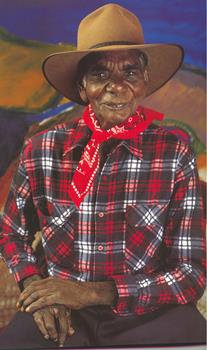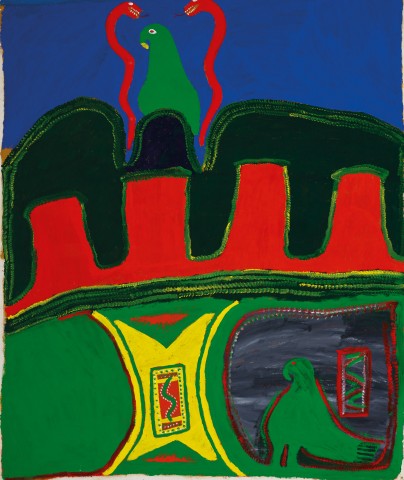THE ARTIST’S COUNTRY: THE FOUR ARCHES, 1990
GINGER RILEY MUNDUWALAWALA
synthetic polymer paint on linen
210.0 x 176.0 cm
bears inscription verso: GR/28
Gallery Gabrielle Pizzi, Melbourne
Private collection, Melbourne, acquired from the above in 1990
Ngukurr, Gallery Gabrielle Pizzi, Melbourne, 17 July - 18 August 1990
Cross Roads - Towards a New Reality: Aboriginal Art from Australia, The National Museum of Modern Art, Kyoto, 22 September - 8 November 1992; The National Museum of Modern Art, Tokyo, 17 November - 20 December 1992, cat. 95 (label attached verso)
Uchiyama, T. (ed.), Cross Roads - Towards a New Reality: Aboriginal Art from Australia, The National Museum of Modern Art, Kyoto, 1992, p. 127 (illus.)
GINGER OPTION 1.jpg

Whilst still in his adolescence, Munduwalawala had a chance encounter with the famed watercolourist Albert Namatjira, whose style was to have an ongoing impact upon his art practice. The meeting with Namatjira was to resonate considerably, forging ‘Riley's idea that the colours of the land as seen in his imagination could be captured in art with munangu paints.’1 Soon after that initial meeting, Riley tried his hand at painting but the results were unsatisfactory to the artist.
Nearly two decades after his first attempt, a second opportunity arose when the Northern Territory Open College of TAFE established a printmaking workshop in the Ngukurr Aboriginal Community, formerly known as the Roper River Mission. Here Munduwalawala was able to experiment once again with the munanga colours of red, blue and yellow, mixing them to create green, purple and pink.
Ginger Riley Munduwalawala grew up on the coastal salt-water country of the Mara people in south-east Arnhem Land. He is the custodian of his mother's country, which extends from the coast of the Gulf of Carpentaria along the Limmen Bight River to the weather worn rocky outcrops known as the Four Archers some fifty kilometres inland. This landscape and its associated mythology is the primary subject matter of his art as Munduwalawala explains, 'My mother’s country is in my mind.’2
Completed in 1990, Artist’s Country, The Four Arches, is centred on this expansive country, incorporating elements of the landscape together with images of the ancient mythological creation stories. Here he utilises strong flattened forms along with his characteristic bright, luminous and often contrasting colours – ‘lots of colour, I play it up, the colour- too much!’3 According to Munduwalawala's story, the snake Garimala, shown this painting as a pair of snakes at the top of the painting, created the Four Arches, an area regarded as '... the centre of the earth, where all things start and finish’.4 Riley noted that Garimala travelled from far away and lives in the waterhole or billabong that he created near the Four Arches. Perched between Garimala and shown again at the bottom right corner is Ngak Ngak, the majestic sea eagle who is the protector and guardian spirit of this country.
From his earliest work, Riley was distinctive for his non-traditional aesthetic, employing brazen colour, subjects painted at dramatically different scales, unusual spatial arrangements, and crooked edged images. Riley's colour choices were daring, and his technique and aesthetic truly unique, thus challenging Western ideas and expectations of Aboriginal painting. His catalogue of work can be viewed as a sequence of variations upon the same events. However, the repetition of Riley's iconography is not a restriction, nor a lack of innovation. Rather, the endurance of his singular narrative allows for a greater depth of exploration, a greater revelation.
1. Ryan, J., Ginger Riley, National Gallery of Victoria, Melbourne, 1997, p. 29
2. Ibid., p. 15
3. Ginger Riley quoted in Perkins H., Art and Soul, The Miegunyah Press, Carlton, 2010 p. 244
4. Ryan, J., p. 49
CRISPIN GUTTERIDGE
